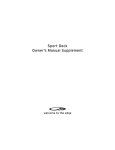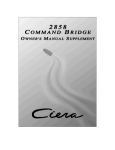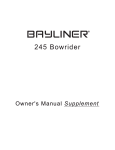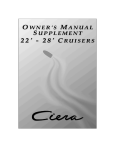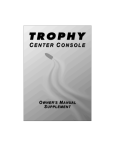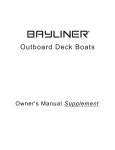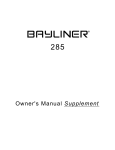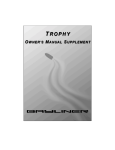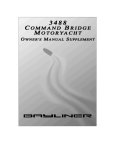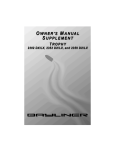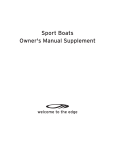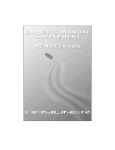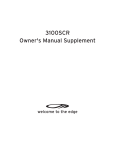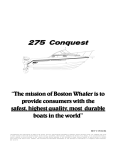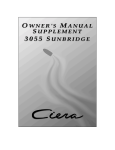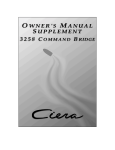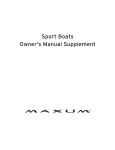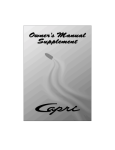Download Bayliner 1802FJ Owner`s manual
Transcript
The information in this Owner’s Manual Supplement relates to 2001 and 2002 Bayliner Trophy Fishing Boats, models: 1700FT, 1703FS, 1802FJ, 1900FG, 2002FF, 2052FD, 2503FM, 2509FW, 2802FH Hull Identification Number: _____________________________________________ Engine Serial Number __________________________________________________ Engine Serial Number __________________________________________________ Hull Identification Number: The Hull Identification Number (HIN) is located on the starboard side of the transom. Record the HIN and the engine serial number in the space provided above. Refer to the HIN for any correspondence or orders. HIN LOCATION (TYPICAL) © 2001 Bayliner Technical Publications. All rights reserved. No part of this publication may be reproduced, stored in any retrieval system, or transmitted in any form by any means, electronic, mechanical, photocopying, recording or otherwise, without prior written permission of Bayliner. Printed in the United States of America. General Notes The material in this document is for information only and is subject to change without notice. While reasonable efforts have been made in the preparation of this document to assure its accuracy, Bayliner assumes no liability resulting from errors or omissions in this document, or from the use of information contained herein. Due to our commitment to product improvement, Bayliner reserves the right to make changes in the product design, specifications, and equipment at any time without notice or obligation. Illustrations and/or photos may show optional equipment. All Bayliner products meet or exceed USCG and/or NMMA construction standarda. Manufactured with 1,1,1 Trichloroethane, a substance which harms public health and environment during the manufacturing process by destroying ozone in the upper atmosphere. Proprietary Rights This document discloses subject matter in which Bayliner has proprietary rights. The information and design disclosed herein were originated by and are the property of Bayliner. Neither receipt nor possession thereof confers or transfers any right to reproduce, copy, alter or disclose the document or any part thereof, any information contained therin, or to construct boats or any item from it, except by written permission from or written agreement with Bayliner. This document is to be returned upon request to Bayliner. CONTENTS CHAPTER 1: ABOUT THIS MANUAL 1 1 2 2 3 3 4 5 Dealer Service Boating Experience Engine & Accessories Guidelines Qualified Maintenance Special Care For Moored Boats Safety Standards Hazard Warning Symbols Carbon Monoxide (CO) 5 6 6 Sources of CO Carbon Monoxide Alarm System What To Do If Carbon Monoxide Is Detected CHAPTER 2: PRODUCT SPECIFICATIONS 7 Specifications CHAPTER 3: COMPONENTS/SYSTEMS 8 Electrical System 9 10 12 Controls 12 12 13 13 13 14 Trim Tabs Navigation and Interior Lights Compass Depth Finder Anchoring Fuel System 14 14 15 16 17 18 12-Volt DC System- Fuses, Circuit Breakers and Switches Shore Power/110 Volt AC System Fuel Fills and Vents Fuel Filters Bilge Blower (2052 FD) Quick Oil Drain System (2052 FD) Fire Port System (2052 FD) Bilge Pump 19 Autofloat Switch 20 21 21 22 23 24 Fresh Water System Marine Head With Pump-out Portable Toilet Bait Well System Alcohol Stove Canvas Top Installations 24 25 26 Center Console Models Bowrider Models Cuddy Cabin Models CHAPTER 4: DRAWINGS & DIAGRAMS 27 28 29 30 31 32 34 36 38 42 1700 (FT) 1703 (FS) 1802 (FJ) 1900 (FG) 1903 (FE) 2002 (FF) 2052 (FD) 2503 (FM) 2509 (FW) 2802 (FH) CHAPTER 4: WIRING DIAGRAMS 47 48 49 50 Shore Power Single Engine (Outboard), Typical Twin Engine (Outboard), Typical Stern Drive, Typical LIMITED WARRANTY 51 51 51 What Is Not Covered Other Limitations Your Obligation 1 CHAPTER 1: ABOUT THIS MANUAL This Owner’s Manual Supplement provides specific information about your boat that is not covered in the Owner’s Manual. Study the Owner’s Manual and this supplement carefully. Pay particular attention to, APPENDIX A: BAYLINER LIMITED WARRANTY in this supplement. Keep the Owner’s Manual and this supplement on your boat in a secure, yet readily available place. Dealer Service Make sure you receive a full explanation of all systems from the selling dealer before taking delivery of your boat. Your selling dealer is your key to service. If you experience any problems with your new boat, immediately contact the selling dealer. If for any reason your selling dealer is unable to help, you can call us direct on our customer service hotline: 360-435-8957 or send us a FAX: 360-403-4235. A Bayliner replacement parts catalog is available online at: http://www.baylinerparts.com. Replacement parts can be purchased from any authorized Bayliner dealer. Boating Experience If this is your first boat or if you are changing to a type of boat you are not familiar with, for your own comfort and safety, you must obtain handling and operating experience before assuming command of the boat. Take one of the boating safety classes offered by the U.S. Power Squadrons or the U.S. Coast Guard Auxiliary. For more course information, including dates and locations of upcoming classes, contact the organizations directly: • U.S. Power Squadrons: 1-888-FOR-USPS (1-888-367-8777) or on the Internet at: http://www.usps.org • U.S. Coast Guard Auxiliary: 1-800-368-5647 or on the Internet at: http://www.cgaux.org Outside the United States, your selling dealer, national sailing federation or local yacht club can advise you of local sea schools or competent instructors. ! WARN ING ! CONTROL HAZARD! A qualified operator must be in control of the boat at all times. DO NOT use your boat while under the influence of alcohol or drugs. Trophy Owner’s Manual Supplement 2 CHAPTER 1: ABOUT THIS MANUAL Engine & Accessories Guidelines Your boat’s engine and accessories were selected to provide optimum performance and service. Installing different engines or other accessories may cause unwanted handling traits. Should you choose to install a different engine or to add accessories that will affect the boat’s running trim, have an experienced marine technician perform a safety inspection and handling test before using your boat again. Be advised that certain modifications to your boat can result in cancellation of your warranty protection. Check with your dealer before making any modifications to your boat. The engine and accessories installed on your boat come with their own operation and maintenance manuals. Read and understand these manuals before operating the engines and accessories. NOT ICE When storing your boat please refer to your engine’s operation and maintenance manuals. Qualified Maintenance ! WARN ING ! To maintain the integrity and safety of your boat, only qualified people should perform maintenance on, or in any way modify: The steering system, propulsion system, engine control system, fuel system, environmental control system, or electrical system. Failure to maintain your boat’s systems as designed could violate the laws in your jurisdiction and could expose you and other people to the danger of bodily injury or accidental death. Follow the instructions provided in the Owner’s Manual, this Owner’s Manual Supplement, the engine owner’s manual and all accessory instruction sheets/manuals included in your boat’s owner’s packet. Trophy Owner’s Manual Supplement CHAPTER 1: ABOUT THIS MANUAL 3 Special Care For Moored Boats If moored in saltwater or fresh water, your boat will collect marine growth on its hull bottom. This will detract from the boat’s beauty, greatly affect its performance and may damage the gelcoat. There are two methods of slowing marine growth: 1. Periodically haul the boat out of the water and scrub the hull bottom with a bristle brush and a solution of soap and water. 2. The hull below the waterline was painted with anti-fouling paint at the factory. Occasionally you will need to re-paint it with a good grade of anti-fouling paint. NOT ICE To help seal the hull bottom and reduce the possibility of gelcoat blistering on moored boats, apply an epoxy barrier coating, such as INTERLUX, Interprotect 2000E/2001E. Cover the barrier coating with several coats of anti-fouling paint. Many states regulate the chemical content of bottom paints. Ask your local dealer about the laws in effect in your area. Safety Standards Your boat’s mechanical and electrical systems were designed to meet safety standards in effect at the time it was constructed. Some of these standards were mandated by law. All of them were designed to insure your safety, and the safety of other people, vessels and property. In addition to this supplement, read the Owner’s Manual, warning labels, and all literature in your owner’s packet for important safety standards and hazard information. ! DAN GER! DANG ER PERSONAL SAFETY HAZARD! DO NOT allow anyone to ride on parts of the boat not designated for such use. Sitting on seat backs, lounging on the forward deck, bow riding, gunwale riding or occupying the transom platform or the aft sunlounge cushions while underway is especially hazardous and WILL cause personal injury or death. ! DAN GER! DANG ER PERSONAL SAFETY HAZARD! Always secure the anchor and other loose objects before getting underway. The anchor and other items that are not properly secured can come loose when the boat is moving and cause personal injury or death. Trophy Owner’s Manual Supplement 4 CHAPTER 1: ABOUT THIS MANUAL Hazard Warning Symbols The hazard warning symbols shown below are used throughout this supplement to call attention to potentially dangerous situations that could lead to either personal injury or product damage. Read these warnings and follow all safety instructions. HOT HAZARD! FIRE HAZARD! PERSONAL INJURY & FALLING HAZARD! ROTATING PROPELLER HAZARD! EXPLOSION HAZARD! OPEN FLAME HAZARD! ELECTRICAL HAZARD! CO POISONING HAZARD! ! DANG ER! This message box alerts you to immediate hazards which WILL cause severe personal injury or death if the warning is ignored. ! WAR NIN G! This message box alerts you to hazards or unsafe practices which COULD result in severe personal injury or death if the warning is ignored. ! CAUTI ON ! This message box alerts you to hazards or unsafe practices which COULD result in minor personal injury or cause product or property damage if the warning is ignored. NOT ICE This message box calls attention to installation, operation or maintenance information, which is important to proper operation but is not hazard related. Trophy Owner’s Manual Supplement CHAPTER 1: ABOUT THIS MANUAL 5 Carbon Monoxide (CO) ! DANG ER! CARBON MONOXIDE POISONING HAZARD! Carbon monoxide gas (CO) is colorless, odorless, and extremely dangerous. All engines, generators, and fuel burning appliances produce CO as exhaust. Direct and prolonged exposure to CO will cause BRAIN DAMAGE or DEATH. Signs of CO poisoning include headache, nausea, dizziness, and drowsiness. Sources of CO include: CO poisoning causes a significant number of boating deaths each year. Called the "silent killer", CO is an extremely toxic, colorless, odorless and tasteless gas. Breathing CO blocks the ability of your blood to carry oxygen. The effects are cumulative, even low levels of exposure can result in injury or death. Sources of CO Sources of CO include: a. Using the engine or generator when the boat is moored in a confined space. b. Mooring close to another boat that is running its engine, generator, or any other CO source. c. Running the boat with the trim angle of the bow too high. d. Running the boat without through ventilation (station wagon effect). To correct stationary situations a and/or b: • Close all windows, portlights and hatches. • If possible, move your boat away from the source of the CO. To correct running situations c and/or d: • Trim the bow down. • Open windows and canvas. • When possible, run the boat so that the prevailing winds will help dissipate the exhaust. IMMEDIATELY take corrective action when CO is detected (see, Carbon Monoxide Alarm System, on the next page). Trophy Owner’s Manual Supplement 6 CHAPTER 1: ABOUT THIS MANUAL Factors increasing the effects of CO include: • Age. • Smokers or people exposed to high concentrations of cigarette smoke. • Consumption of alcohol. • Lung disorders, heart problems, and pregnancy. Carbon Monoxide Alarm System Your boat may feature a carbon monoxide (CO) alarm system. DO NOT DISCONNECT THE ALARM SYSTEM. Read and understand the manufacturer’s instructions for your CO alarm system. If you did not receive an instruction manual, call (800) 3830269 and one will be mailed to you. If your boat is not equipped with a carbon monoxide alarm, consider purchasing one from your dealer or marine supply store. MARINE TECHNOLOGIES INC. CARBON MONOXIDE ALARM MODEL 60-541 (REPLACE AFTER TEN YEARS OF USE) What To Do If Carbon Monoxide Is Detected • Immediately ventilate any enclosed spaces that are occupied by people and reset your CO alarm. • Immediately move anyone showing any symptoms of CO poisoning into fresh air. See a doctor if any symptoms persist. If the person is unconscious, immediately administer oxygen or CPR and call for emergency help. Trophy Owner’s Manual Supplement 7 CHAPTER 2: PRODUCT SPECIFICATIONS Overall Length Bridge Clearance Bridge Clearance With Hard Top or T-Top (Option) Beam Maximum Draft Fuel Tank Capacity (gal) ater Tank apacity (gal) Holding Tank Capacity (gal) Specifications 1700 (FT) Trophy Dual Console 17’ 0” 4’ 3” N/A 7’ 2” 2’ 7” 37 N/A N/A 1703 (FS) Trophy Center Console 17’ 0” 4’ 9” N/A 7’ 2” 2’ 5” 37 N/A N/A 1802 (FJ) Trophy Cuddy 18’ 0” 5’ 2” N/A 7’ 6” 2’ 7” 52 N/A N/A 1900 (FG) Trophy Dual Console 19’ 0” 4’ 3” N/A 8’ 2” 2’ 9” 55 N/A N/A 1903 (FE) Trophy Center Console 19’ 0” 5’ 10” 7’ 9” 8’ 2” 2’ 8” 55 N/A N/A 2002 (FF) Trophy Walkaround 21’ 7” 5’ 7” 7’ 4” 8’ 1” 2’ 9” 85 N/A N/A 2052 (FD) Trophy Walkaround 21’ 7” 5’ 6” 7’ 3” 8’ 1” 2’ 9” 65 N/A N/A 2503 (FM) Trophy Center Console 27’ 3” 6’ 2” 7’ 11” 8’ 5” 2’ 9 150 N/A N/A 2509 (FW) Trophy Cuddy 27’ 3” 6’ 7” 8’ 1” 8’ 5” 2’ 5” 147 8 N/A 2802 (FH) Trophy Cuddy 31’ 0” 7’ 5” 9’ 6” 9’ 9” 2’ 6” 240 30 30 Model Description Trophy Owner’s Manual Supplement 8 CHAPTER 3: COMPONENTS/SYSTEMS Electrical System Thoroughly read and understand this section, the electrical sections of the Owner’s Manual and all accessory manuals included in your boat’s owner’s packet. Wiring schematics are provided at the back of this supplement. ! • • • • • DANG ER! EXTREME FIRE, ELECTRIC SHOCK and EXPLOSION HAZARD! To minimize the risks of fire, electric shock and explosion: NEVER install knife switches or other arcing devices in fuel compartments. NEVER substitute automotive parts for marine parts. Electrical, ignition and fuel system parts were designed and manufactured to comply with rules and regulations that minimize risks of fire and explosion. Ensure all of the battery switches are in the OFF position before performing any work in the engine spaces. DO NOT modify the electrical systems or relevant drawings. Only qualified personnel should install batteries and/or perform maintenance on the electrical system. ! WAR NIN G! FIRE & EXPLOSION HAZARD! • Fuel fumes are heavier than air and will collect in the bilge areas where they can be accidently ignited. Visually and by smell (sniff test), check the engine and fuel compartments for fumes or accumulation of fuel. Always use the bilge blowers for at least four minutes prior to engine starting, electrical system maintenance or activation of electrical devices. • Minimize the danger of fire and explosion by not exposing batteries to open flame or sparks. NEVER allow smoking anywhere near the batteries. NOTIC E Electrical connections are prone to corrosion. To reduce corrosion caused electrical problems, keep all electrical connections clean and apply a spray-on protectant that is designed to protect connections from corrosion. Trophy Owner’s Manual Supplement CHAPTER 3: COMPONENTS/SYSTEMS 9 ! CAUTI ON ! SHOCK & ELECTRICAL SYSTEM DAMAGE HAZARD! • NEVER disconnect the battery cables while the engine is running since damage may occur to your boat’s electrical system components. • The parallel switch should be turned on only in emergencies. • The battery charging systems (alternators and battery charger) are designed to charge lead-acid batteries. Before installing gel-cell or other new technology batteries, read and follow the battery charger’s operating instructions. 12-Volt DC System- Fuses, Circuit Breakers and Switches TYPICAL ACCESSORY CIRCUIT MASTER BREAKER The engine is protected by a large circuit breaker on the engine. The accessories on some models are protected by a master circuit breaker usually located near the battery. In addition, a fuse block for branch accessory circuits is located near the helm panel. Wires are color-coded to indicate which accessory each fuse services. Some items, such as radios and bilge pumps, may be fused individually at the unit. Autofloat switches are fused at the battery. FUSE BLOCK (TYPICAL) 12v POWER SUPPLY, RED WIRE DEPTH FINDER (OPTION), RED WIRE 10 amp 10 amp BLANK (SPARE 10 amp) 10 amp 15 amp BLOWER (I.O. BOATS ONLY), YELLOW WIRE 5 amp 10 amp HORN, BROWN/ GREEN WIRE INSTRUMENTS, BLUE WIRE 10 amp 10 amp NAVIGATION/ANCHOR LIGHTS, BLUE WIRE BILGE PUMP, BROWN WIRE 5 amp 10 amp STEREO, RED WIRE IGNITION SWITCH (I.O. BOATS ONLY), RED/PURPLE WIRE Some models are equipped with battery switches. Your Owner’s Manual provides a general description of battery switch function in the Batteries portion of the Electrical Section. TYPICAL BATTERY SWITCHES STBD BATTERY PORT (OR ONLY) BATTERY Trophy Owner’s Manual Supplement 10 CHAPTER 3: COMPONENTS/SYSTEMS Shore Power/110 Volt AC System ! • • • • • DANG ER! FIRE, ELECTRIC SHOCK and EXPLOSION HAZARD! To minimize the risks of fire, electric shock and explosion: DO NOT alter shore power connectors and use only compatible connectors. Before connecting or disconnecting the shore power cord to your boat, make sure all breakers and switches on the AC master panel are turned OFF. To prevent shock or injury from an accidental dropping of the “hot” cord into the water, ALWAYS attach the shore power cord to the boat inlet first; then to the dockside connection. When disconnecting from shore power, disconnect the shore power cord from the dockside connection first. NEVER leave a shore power cord connected to the dockside connection only. Only use shore power cords approved for marine use. NEVER use ordinary indoor or outdoor extension cords that are not rated for marine use. ! CAUTI ON ! SHOCK & ELECTRICAL SYSTEM DAMAGE HAZARD! • Monitor the polarity indicator lights EVERY TIME you connect to shore power. • When connecting to shore power and you encounter a reversed polarity light (RED colored), DO NOT energize the main breaker switches. Instead, IMMEDIATELY disconnect the shore power cord (ALWAYS from the dockside receptacle first) and notify marina management. ! WAR NIN G! SHOCK & ELECTRICAL SYSTEM DAMAGE HAZARD! • Periodically check the shore power cord(s) for deterioration or damage. Damaged or faulty cords should NEVER be used since the danger of fire and electrical shock exists. • DO NOT pinch shore power cords in doors or hatches, or coil the shore power cord too tightly since these situations can generate enough heat to result in a fire. • If a shore power cord should accidently become immersed in water, THOROUGHLY dry the blades and contact slots before reusing. NOTIC E Some dockside installations may be rated less than 30 amps, therefore, you may need to purchase lower amp adapters. Whenever a lower amp adapter is used, however, there will be a corresponding drop in supplied power from the dockside system. Trophy Owner’s Manual Supplement CHAPTER 3: COMPONENTS/SYSTEMS 11 ! CAUTI ON ! SHOCK & ELECTRICAL SYSTEM DAMAGE HAZARD! • NEVER connect dockside power to your boat outside North America unless you have purchased the international electrical conversion option. • The simultaneous use of several AC components can result in an overloaded circuit. It may be necessary to turn off one or more accessories in order to use another accessory. • Use double insulated or three-wire protected electrical appliances whenever possible. SHORE POWER INLET 110 VOLT AC PANEL GALLEY AREA Trophy Owner’s Manual Supplement 12 CHAPTER 3: COMPONENTS/SYSTEMS Controls Read and understand the Controls section of both the Owner’s Manual and engine manual, provided in the owner’s packet, for instructions and warranty information. Trim Tabs ! WAR NIN G! LOSS OF CONTROL HAZARD! Improper use of trim tabs will cause loss of control! • Do not allow anyone unfamiliar with trim tabs to use them. • Do not use trim tabs in a following sea as they will cause broaching or other unsafe handling characteristics. • Do not use trim tabs to compensate for excessive unequal weight distribution. The trim tabs may be used to help keep your boat level at cruising speeds. TYPICAL TRIM TAB ROCKER SWITCHES The trim tabs are controlled by two rocker switches at each helm station. Before using the trim tab rocker switches, read and understand the trim tab operation manual included in your yacht’s owner’s packet. TRANSOM TYPICAL TRIM TAB When cruising speed is reached: • The port or starboard trim switch may be used (one at a time) to level the boat. • Perform trim tab adjustment with several short touches to the switch rather than one long one. • After each short touch allow several seconds for the hull to react. Navigation and Interior Lights Read the navigation light section of the Owner’s Manual. The navigation and interior lights supplied with your boat are of top quality, but you should be aware that failure may periodically occur for a variety of reasons: • There may be a blown fuse - replace the fuse in the switch panel. • The bulb may be burned out - carry spare bulbs for replacement. • A wire may be damaged or may have come loose - repair as required. • The bulb base may be corroded - clean the base and coat it with non-conductive electrical lubricant. ! CAUTIO N! • Conserve battery power. Prolonged operation of cabin interior lights (overnight) will result in a drained battery. • Avoid the storage of gear where it would block navigation lights from view. Trophy Owner’s Manual Supplement CHAPTER 3: COMPONENTS/SYSTEMS 13 Compass Your boat may come equipped with a compass. Carefully read and follow the manufacturer’s calibration and operating instructions provided in the owner’s packet. Depth Finder Your boat may come equipped with a depth finder. It will provide you with measurements of water depth beneath the boat and in many cases it may help you locate schools of fish. The depth finder comes with its own manual. We suggest that you read it carefully before using the unit. ! WARN ING ! DO NOT use the depth finder as a navigational aid to prevent collision, grounding, boat damage or personal injury. When the boat is moving, submerged objects will not be seen until they are already under the boat. Bottom depths may change too quickly to allow time for the boat operator to react. If you suspect shallow water or submerged objects, run the boat at very slow speeds. Anchoring Read and understand the Anchoring section of the Owner’s Manual. ! WAR NIN G! FIRE/EXPLOSION HAZARD DO NOT open the engine cover until the fire is extinguished. Trophy Owner’s Manual Supplement 14 CHAPTER 3: COMPONENTS/SYSTEMS Fuel System Fuel Fills and Vents Fuel fills are located either on the aft deck or on the side decks adjacent to the aft cockpit. Fuel receptacle caps are marked “GAS”. Fuel vents are normally located in the hull or transom below and in the same general area as the fill. If you have trouble filling the fuel tank, check to see that the fuel fill and vent lines are free of obstructions and kinks. Fuel Filters Fuel filters should be replaced periodically to ensure that they remain clean and free of debris. A fine mesh screen filter is located on the fuel pickup tube. An additional filter, when supplied by the engine manufacturer, is installed on the engine. Consult your selling dealer or local marina concerning fuel additives that help to prevent fungus or buildup in your fuel tanks. TYPICAL FUEL SYSTEM FUEL TANK DECK FITTING FUEL FILL FWD FUEL TANK VENT FUEL FEED HOSE ! WAR NIN G! FIRE/EXPLOSION HAZARD It is very important that the fuel system be inspected thoroughly the first time it is filled and then at each subsequent filling. For your safety and the safety of your passengers, the fueling instructions in the Owner’s Manual must be followed. ! CAUTI ON ! Avoid the storage or handling of gear near the fuel lines, fittings and tank. Trophy Owner’s Manual Supplement CHAPTER 3: COMPONENTS/SYSTEMS 15 Bilge Blower (2052 FD) ! WAR NIN G! FIRE/EXPLOSION HAZARD Operation of the blower system is NOT A GUARANTEE that explosive fumes have been removed. If you smell any fuel, DO NOT start the engine. If the engine is already running, immediately shut off the engine and all electrical accessories. Investigate immediately. DO NOT obstruct or modify the ventilation system. BLOWER SYSTEM & AIRFLOW DIRECTION VENTILATION HOSES TRANSOM COLLECTION BOX BLOWER The bilge blower removes fumes from the engine compartment and draws fresh air into the compartment through the deck vents. To ensure fresh air circulation, use the bilge blower for at least four minutes before starting the engine, during starting, and while running the boat below cruising speed. Trophy Owner’s Manual Supplement 16 CHAPTER 3: COMPONENTS/SYSTEMS Quick Oil Drain System (2052 FD) All stern drive models are equipped with a quick oil drain system. To drain the engine oil: 1. Remove the boat from the water. 2. Unscrew the garboard drain plug. 3. Pull the draw cord until the oil drain plug and the oil drain hose slide out of the garboard drain. 4. Place the end of the oil drain hose into a suitable container. 5. Unscrew the oil drain plug and drain the engine oil. 6. Replace the oil drain plug. 7. Push the drain hose back into the bilge. 8. Replace the garboard drain plug. Always dispose of waste oil in accordance with local regulations. QUICK OIL DRAIN SYSTEM OIL DRAIN HOSE TRANSOM OIL DRAIN PLUG GARBOARD DRAIN PLUG DRAW CORD BILGE GARBOARD DRAIN Trophy Owner’s Manual Supplement ENGINE OIL PAN CHAPTER 3: COMPONENTS/SYSTEMS 17 Fire Port System (2052 FD) Stern drive models have a Fire Port located on the motor box. In the event of an engine fire: 1. Lift the fire port cover. 2. Discharge a Class B fire extinguisher into the engine compartment through the fire port. 1. 2. Trophy Owner’s Manual Supplement 18 CHAPTER 3: COMPONENTS/SYSTEMS Bilge Pump TYPICAL BILGE PUMP SYSTEM Your boat has one impeller-type bilge pump. The bilge pump is automatically controlled by a float switch (see "Autofloat Switch" on the next page). The bilge pump can also be controlled by a switch on the dash. TRANSOM FLOAT SWITCH BILGE PUMP Check the bilge pump often to make sure it is working properly. To check the bilge pump: • Turn on the dash-mounted switch and make sure that water in the bilge is pumped overboard. HOSE If bilge water is present and the pump motor is running but not pumping: • Inspect the bilge pump hose for a kink or collapsed area. THRUHULL If the bilge pump hose is not the problem, check the bilge pump housing for clogging debris: Bilge Pump Cleaning: To remove the power cartridge: 1. Lift the tab while rotating the fins counterclockwise. 2. Lift out the power cartridge. 3. Clear the outer housing of debris. To reinstall the power cartridge: 1. Make sure the “O” ring is properly seated. 2. Coat the “O” ring with a light film of vegetable or mineral oil. 3. Align the two cams on either side of the power cartridge with the two slots on the outer housing and press the power cartridge into the housing while twisting clockwise. 4. To ensure proper reinstallation of the power cartridge, attempt to twist the fins counterclockwise without lifting the tab: The cartridge should stay in place. Trophy Owner’s Manual Supplement BILGE PUMP COMPONENTS FIN TAB LIGHT FILM OF OIL CAM (TYPICAL) “O” RING POWER CARTRIDGE SLOT (TYPICAL) OUTER HOUSING CHAPTER 3: COMPONENTS/SYSTEMS 19 Autofloat Switch An electromagnetic float (autofloat) switch automatically turns on the bilge pump whenever bilge water rises above a preset level. An autofloat switch is mounted next to the bilge pump. The autofloat switch is wired directly to the battery and will normally function even when the boat is completely shut down and left unattended. Test the autofloat switch often as follows: Float Switch Test: FLOAT SWITCH TEST BUTTON DOWN - AUTO POSITION UP - TEST POSITION 1. Lift the float switch test button to turn on the bilge pump. 2. If the pump does not turn on, check the inline fuse. If the fuse is good but the switch doesn’t work, it may indicate a bad switch or possibly a low battery. 3. Push the test button all the way back down to auto mode. ! CAUTI ON ! When test is completed on a float switch, you must push the test button all the way down to the auto position to turn the switch back to auto mode! NOT ICE Discharge of oil, oil waste or fuel into navigable waters is prohibited by law. Violators are subject to legal action by the local authorities. Trophy Owner’s Manual Supplement 20 CHAPTER 3: COMPONENTS/SYSTEMS Fresh Water System Fresh water systems are available on some models. These pressure-type (demand) systems operate when the water pump switch (located near the sink in the cuddy cabin) is in the ON position. Turn the pump switch OFF when the boat is not in use and when the water tank is empty. Stored water can become stagnant and distasteful. Pump the water tank dry before leaving your boat unattended for long periods of time. Occasionally you may want to disinfect your water system. Ask your selling dealer about available treatments and procedures. Your boat may be equipped with a transom shower. Please read and follow the manufacturer’s operating instructions supplied in your owner’s packet. TYPICAL FRESH WATER SYSTEM COMPONENTS TO TRANSOM SHOWER ON AFT DECK PO T AF RT WATER PUMP WATER TANK TO SINK FAUCET DRAIN SINK HOSE FAUCET WATER PUMP SWITCH & LABEL Trophy Owner’s Manual Supplement CHAPTER 3: COMPONENTS/SYSTEMS 21 Marine Head With Pump-out If your boat features a marine head and pump out system, carefully read the manufacturer’s owner’s manual supplied in your owner’s packet. Portable Toilet PORTABLE TOILET STORAGE LOCATION (TYPICAL) Your boat may feature a portable toilet. Read and follow the manufacturer’s operating instructions supplied in your owner’s packet before using your portable toilet. Trophy Owner’s Manual Supplement 22 CHAPTER 3: COMPONENTS/SYSTEMS Bait Well System Your boat may feature a bait well. A typical bait well system features • A hi-speed pickup located on the underside of the hull. • A seacock valve is attached to the pickup. The seacock allows for immediate shutdown if needed. • A water pump. This pump is normally located in the bilge area or possibly higher in a storage area. BAIT WELL STAND PIPE DRAIN AERATOR VALVE REMOVE STAND PIPE TO COMPLETELY DRAIN BAIT WELL The water continues from the TYPICAL BAIT WELL pump to the aerator valve and into DRAIN SYSTEM the bait well. On some models, water is also directed to the raw water wash down from this system. Typically, bait wells have an overflow stand pipe and a full drain system. The bait well switch is on or near the main dash panel. The water pump will pump a constant flow of water into the bait well when the seacock is open and the switch is on. TYPICAL BAIT WELL SYSTEM COMPONENTS BAIT WELL WATER PUMP WATER FILTER TO RAW WATER WASH DOWN SEACOCK HI-SPEED PICKUP Trophy Owner’s Manual Supplement CHAPTER 3: COMPONENTS/SYSTEMS 23 Alcohol Stove ! WAR NIN G! Reduce the possibility of fire by removing all combustible materials away from the stove before/during use. If your boat features a single burner alcohol stove, carefully read and follow the manufacturer’s operating instructions supplied in your owner’s packet before using your stove for the first time. ! DANG ER! CARBON MONOXIDE POISONING HAZARD! The alcohol stove is a potential source of dangerous carbon monoxide gas (CO). Do not use without adequate ventilation. ! WAR NIN G! FIRE/EXPLOSION HAZARD FIRE HAZARD. The portable stove must be placed in the designated operating location when in use (see photos below). CORRECT LOCATION OF STOVE DURING USE NEVER USE STOVE ON THIS COUNTER TOP! PROXIMITY TO OVERHEAD IS A FIRE HAZARD. STOVE STORAGE AREA Trophy Owner’s Manual Supplement 24 CHAPTER 3: COMPONENTS/SYSTEMS Canvas Top Installations ! C A U T IO N ! Take down and securely stow the convertible top, side curtains and back cover before transporting your boat by road. Center Console Models HOLD DOWN STRAP HOOK DECK EYELET JAW SLIDE SECURING PIN DECK HINGE END EYE 1. Slide the end eyes of the main bow (A) into the aft deck hinges (B) and insert the securing pins. 2. Connect the hold down straps (C) to the deck eyelets (D). 1. Slide the end eyes of the forward braces (E) into the forward deck hinges (F) and insert the securing pins. 1. Attach the side braces (G) to the quick release jaw slides on the secondary bow (H) and insert the securing pins. 2. Adjust the jaw slides, if needed, to obtain a tight bimini top. Tighten the set screws to hold the bimini in place. 3. Tighten the hold down straps (C) at the forward end of the bimini top. Trophy Owner’s Manual Supplement CHAPTER 3: COMPONENTS/SYSTEMS 25 Bowrider Models E C F G A D B H SECURING PIN JAW SLIDE DECK HINGE END EYE HOLD DOWN STRAP HOOK DECK EYELET 1. Slide the end eyes of the main bow (A) into the aft deck hinges (B) and insert the securing pins. 2. Slide the end eyes of the forward supports (C) into the forward deck hinges (D) and insert the securing pins. 3. Attach the hooks of the forward hold down straps (E) to the forward deck eyelets (F) and tighten the straps. 4. Attach the hooks of the aft hold down straps (G) to the aft deck eyelets (H) and tighten the straps. 5. No adjustments to the jaw slides should be needed as they are preset during manufacturing. Before attempting to adjust the jawslide positions, obtain the correct measurements from you selling dealer. Trophy Owner’s Manual Supplement 26 CHAPTER 3: COMPONENTS/SYSTEMS Cuddy Cabin Models H I L K J E D A C F NOTE: SOME HINGES MAY BE LOCATED ON DECK B G SECURING PIN DECK HINGE JAW SLIDE END EYE 1. Slide the end eyes of the main bow (A) into the mid deck hinges (B) and secure with the pins. 2. Attach the forward braces (C) to the secondary bow (D). 3. Slide the end eyes of the forward braces into the forward deck hinges (E) and secure with the pins. 4. Attach the aft braces (F) to the main bow (A). 5. Slide the end eyes of the aft braces into the aft deck hinges (G) and secure with the pins. 6. Make the canvas taut by pulling aft and down on the aft edge (H) of the bimini top while securing the aft brace jaw slide (I). Also pull forward and down on the forward edge (J) of the bimini top while securing the forward brace jaw slide (K). 7. Tighten the top straps (L), if needed, by adjusting the buckle slides. 8. Additional canvas (i.e. side curtains, slant back cover or camper cover) should be secured to the top canvas before final adjustment. Like the top, the additional canvas should be smooth and taut. Trophy Owner’s Manual Supplement 27 CHAPTER 4: DRAWINGS & DIAGRAMS 1700 (FT) Hull Exterior View DECK DRAIN BAIT WELL DRAIN PORT HULLSIDE BILGE PUMP OVERBOARD STARBOARD HULLSIDE BOW EYE DECK DRAIN TRANSOM STERN EYES GARBOARD DRAIN Deck Wire Routing VIEW IS UNDERSIDE OF DECK GROUND TO BATTERY SPEAKERS GROUNDING STERN LIGHT BLOCK HORN TO DASH SHIFTER FUEL TANK SENDER BILGE PUMP BOW LIGHT ENGINE HARNESS LIVE WELL PUMP SPEAKERS STEREO Trophy Owner’s Manual Supplement 28 CHAPTER 4: DRAWINGS & DIAGRAMS 1703 (FS) Hull Exterior View BAIT WELL DRAIN DECK DRAIN PORT HULLSIDE STARBOARD HULLSIDE BOW EYE BILGE PUMP OVERBOARD DECK DRAIN STORAGE DRAIN TRANSOM STERN EYES SCUPPER, TYPICAL PORT & STBD GARBOARD DRAIN Deck Wire Routing VIEW IS UNDERSIDE OF DECK ANCHOR LIGHT GROUNDING BLOCK BATTERY SWITCH TO DASH BOW LIGHT LIVE WELL PUMP BILGE Trophy Owner’s Manual Supplement FUEL TANK SENDER CHAPTER 4: DRAWINGS & DIAGRAMS 29 1802 (FJ) Hull Exterior Hardware BAIT WELL DRAIN DECK DRAIN PORT HULLSIDE STARBOARD HULLSIDE BOW EYE BILGE PUMP OVERBOARD DECK DRAIN STORAGE DRAIN TRANSOM STERN EYES GARBOARD DRAIN Electrical Harness VIEW IS UNDERSIDE OF DECK DOME LIGHT WIPER (OPTION) BOW LIGHT STERN LIGHT SUMP Trophy Owner’s Manual Supplement 30 CHAPTER 4: DRAWINGS & DIAGRAMS 1900 (FG) Hull Exterior Hardware BAIT WELL DRAIN DECK DRAIN PORT HULLSIDE STARBOARD HULLSIDE BOW EYE BILGE PUMP OVERBOARD DECK DRAIN TRANSOM STORAGE DRAIN STERN EYES GARBOARD DRAIN Wire Harness Routing UNDERSIDE OF DECK GROUND BLOCK STERN LIGHT SPEAKERS HORN SHIFTER TO DASH GROUND TO BATTERY FUEL TANK SENDER EXTRA SPEAKER WIRE BILGE PUMP ENGINE HARNESS LIVE WELL PUMP SPEAKERS Trophy Owner’s Manual Supplement STEREO BOW LIGHT CHAPTER 4: DRAWINGS & DIAGRAMS 31 1903 (FE) Hull Exterior Hardware BAIT WELL DRAIN DECK DRAIN PORT HULLSIDE STARBOARD HULLSIDE BOW EYE DECK DRAIN BILGE PUMP OVERBOARD STORAGE DRAIN TRANSOM STERN EYES GARBOARD DRAIN Wire Harness Routing UNDERSIDE OF DECK GROUNDING BLOCK TO BATTERY SWITCH BILGE PUMP ANCHOR LIGHT TO DASH BOW LIGHT LIVEWELL PUMP FUEL TANK SENDER Trophy Owner’s Manual Supplement 32 CHAPTER 4: DRAWINGS & DIAGRAMS 2002 (FF) Hull Exterior Hardware FISH WELL DRAIN PORT HULLSIDE BOW EYE FISH WELL DRAIN FUEL VENT STARBOARD HULLSIDE ROPE LOCKER DRAIN BILGE PUMP OVERBOARD LIVE WELL DRAIN DECK DRAINS (TYPICAL PORT/STBD) TRANSOM STERN EYES GARBOARD DRAIN Trophy Owner’s Manual Supplement TRIM TAB (TYPICAL PORT/STBD) CHAPTER 4: DRAWINGS & DIAGRAMS 33 Deck & Bilge Harness STERN LIGHT COURTESY SPEAKER LIGHT SHIFTER FUEL FISH WELL KILL GROUND PUMP SWITCH DASH PLUG WIPER COMPASS HORN BILGE PLUG STERN LIGHT ENGINE PLUG BOW LIGHTS ACCY BREAKER INTERIOR LIGHT STEREO SPEAKER FISH WELL PUMP WIPER ANTENNA WIRE COURTESY LIGHT BILGE HARNESS PLUG TO BILGE PUMP & FLOAT SWITCH TO BAIT WELL PUMP TO FUEL SENDER Head Pump-out (Option) PORTA-POTTY VENT PORTA-POTTY Trophy Owner’s Manual Supplement 34 CHAPTER 4: DRAWINGS & DIAGRAMS 2052 (FD) Hull Exterior Hardware FISH WELL DRAIN PORT HULLSIDE BOW EYE FISH WELL DRAIN FUEL VENT STARBOARD HULLSIDE ROPE LOCKER DRAIN LIVE WELL DRAIN BILGE PUMP OVERBOARD DECK DRAINS (TYPICAL PORT/STBD) TRANSOM TRIM TAB (TYPICAL PORT/STBD) STERN EYES GARBOARD DRAIN Electrical Harness Routings ENGINE PLUG BILGE PLUG STBD. FISHWELL PUMP TRIM PUMP BAIT WELL PUMP STBD. COURTESY LIGHT PORT FISHWELL PUMP BLOWER FUEL GROUND STERN LIGHT STBD. SPEAKER BUSS BAR SHIFTER KILL SWITCH PORT COURTESY LIGHT DASH PLUG BILGE HARNESS PLUG TRANSOM STBD. WIPER PORT SPEAKER STEREO ANTENNA WIRE COMPASS LIGHT INTERIOR LIGHT HORN PORT WIPER PORT BOW LIGHT Trophy Owner’s Manual Supplement STBD. BOW LIGHT BILGE PUMP & FLOAT SWITCH TO FUEL SENDER CHAPTER 4: DRAWINGS & DIAGRAMS 35 Raw Water (Option) WASHDOWN OUTLET WASHDOWN PUMP SEA STRAINER Marine Head (Option) HOLDING TANK MACERATOR PUMP TANK VENT THRU-HULL DECK WASTE FITTING SEACOCK TANK VENT THRU-HULL V-BERTH VIEW HEAD SUMP BOX HEAD Trophy Owner’s Manual Supplement 36 CHAPTER 4: DRAWINGS & DIAGRAMS 2503 (FM) Hull Exterior Hardware STARBOARD HULLSIDE BILGE PUMP DRAIN SUMP BILGE PUMP DRAIN FISH WELL DRAIN TRANSOM DECK DRAINS (TYPICAL PORT/STBD) TRIM TABS (TYPICAL PORT/STBD) GARBOARD DRAIN Fish Well/Bait Well Sump System FROM FISHWELL SUMP BOX FLOAT SWITCH FROM AERATOR TANK BILGE PUMP FROM FWD BILGE FROM FISHWELL TO THRU-HULL Head Pump-out System (Option) TO WASTE DECK FITTING TANK VENT THRU-HULL PORTA-POTTY Trophy Owner’s Manual Supplement CHAPTER 4: DRAWINGS & DIAGRAMS 37 Wire Harness Routing STERN LIGHT TO CONSOLE BOW LIGHT UNDERSIDE OF DECK VIEW COURTESY LIGHTS SUMP PUMP GARBOARD TO BILGE DRAIN PUMP GROUND SEACOCK GROUND CONSOLE HULL TOP VIEW TO MOTOR FUEL TANK SENDER BATTERY AERATOR PUMP Water Systems (Options) WATER FILL DECK FITTING WATER TANK VENT THRU-HULL TO DECK FRESH WATER SYSTEM (OPTION) SEA STRAINER WATER TANK TO WASHDOWN ON DECK PUMP RAW WATER WASHDOWN SYSTEM (OPTION) FRESH WATER PUMP Trophy Owner’s Manual Supplement 38 CHAPTER 4: DRAWINGS & DIAGRAMS 2509 (FW) Hull Exterior Hardware FWD BILGE PUMP DRAIN MACERATOR DRAIN (OPTION) WATER TANK VENT STBD HULLSIDE GALLEY SINK DRAIN AFT BILGE PUMP DRAIN HOLDING TANK VENT (OPTION) FISHWELL SUMP DRAIN PORT HULLSIDE TRANSOM DECK DRAINS (TYPICAL PORT/STBD) TRIM TAB (TYPICAL PORT/STBD) GARBOARD DRAIN Deck Hardware ENLARGED VIEW WATER FILL MARINE HEAD PUMP OUT DECK FITTING (OPTION) Trophy Owner’s Manual Supplement CHAPTER 4: DRAWINGS & DIAGRAMS 39 Deck Harness BILGE HARNESS FWD HULL SHIFTER HARNESS DASH PANEL COURTESY LIGHT SPEAKER COMPASS TRIM PUMP WIPER HORN BOW LIGHT ENGINE FUEL TANK STERN LIGHT SPEAKER COURTESY LIGHT CABIN LIGHT STEP LIGHT CABIN LIGHT Fishwell Drain System THRU-HULL BILGE PUMP SUMP BOX FLOAT SWITCH Bait Well Pick-up System HIGH SPEED PICK-UP BAIT WELL PUMP PUMP TO AERATOR TO BAIT WELL TANK Trophy Owner’s Manual Supplement 40 CHAPTER 4: DRAWINGS & DIAGRAMS Galley Water System HAND PUMP TANK VENT THRU-HULL WATER TANK WATER FILL DECK FITTING HOSE COVER Marine Head (Option) HOLDING TANK SUMP BOX HEAD SEA STRAINER HEAD HOLDING TANK VENT THRU-HULL Macerator (Option) MACERATOR PUMP DECK WASTE FITTING Trophy Owner’s Manual Supplement TANK VENT THRU-HULL CHAPTER 4: DRAWINGS & DIAGRAMS 41 Raw Water (Option) WASHDOWN OUTLET WASHDOWN PUMP SEA STRAINER Fresh Water Washdown System (Option) TO WATER FILL DECK FITTING WATER TANK TO WASHDOWN ON DECK PUMP Trophy Owner’s Manual Supplement 42 CHAPTER 4: DRAWINGS & DIAGRAMS 2802 (FH) Hull Exterior Hardware BAIT WELL DRAIN WATER TANK VENT COCKPIT SINK DRAIN SHOWER FUEL DRAIN VENT ANCHOR DRAIN COVER STBD HULLSIDE BOW EYE FWD BILGE PUMP MACERATOR HOLDING TANK VENT PUMP OUT (OPTION) GALLEY SINK DRAIN AFT SINK DRAIN COCKPIT SINK DRAIN AFT BILGE PUMP PORT HULLSIDE FISHWELL DRAIN TRANSOM VIEW RIGGING TUBES STERN EYE (TYPICAL PORT/STBD) Trophy Owner’s Manual Supplement TRIM TABS GARBOARD DRAIN CHAPTER 4: DRAWINGS & DIAGRAMS 43 Deck Electrical Harness COURTESY LIGHT LIGHT SPEAKER LIGHT WIPER SPEAKER HORN LIGHT BOW LIGHT LIGHT SPEAKER LIGHT LIGHTS RADIO PLUG SWITCHES WIPER SPEAKER COURTESY LIGHT Shore Power Routing FROM AC PANEL TO HEAD OUTLET TO HOT WATER HEATER TO BATTERY CHARGER Waste Holding Tank TANK TO DECK FITTING TO VENT THRU-HULL TANK TO MACERATOR FROM HEAD WASTE TANK Trophy Owner’s Manual Supplement 44 CHAPTER 4: DRAWINGS & DIAGRAMS Head Wire Routing FWD VIEW ROUTE TO OUTLET DOOR TO HEAD WATER HEATER LOCATION (OPTION) TO WATER HEATER (OPTION) Deck Washdown System SEACOCK TO PUMP WASHDOWN THRU-HULL WASHDOWN PUMP Head Pick-up System AFT PICKUP TO HEAD TO THRU-HULL HEAD Trophy Owner’s Manual Supplement CHAPTER 4: DRAWINGS & DIAGRAMS 45 Bait Well System THRU-HULL TO BAIT WELL FILTER ON TRANSOM DECK FROM SEACOCK TO PUMP BAIT WELL PICKUP SUMP Deck Transom Hook-ups FILTER BATTERY SWITCH BAIT WELL PUMP LOWER BAIT WELL DRAIN TO AERATOR Macerator Pump Location TO DECK WASTE FITTING TO HEAD MACERATOR PUMP MACERATOR DISCHARGE Trophy Owner’s Manual Supplement 46 CHAPTER 4: DRAWINGS & DIAGRAMS Aft Liner Drain System FISH WELL TO SUMP TO THRU-HULL FISH WELL (TYPICAL PORT/STBD) LINER DRAIN THRU-HULL Hot Water System (Option) HOT TO HEAD SINK FROM WATER HEATER HOT TO GALLEY SINK Trophy Owner’s Manual Supplement 47 CHAPTER 4: WIRING DIAGRAMS Shore Power Trophy Owner’s Manual Supplement 48 CHAPTER 4: WIRING DIAGRAMS Single Engine (Outboard), Typical Trophy Owner’s Manual Supplement CHAPTER 4: WIRING DIAGRAMS 49 Twin Engine (Outboard), Typical Trophy Owner’s Manual Supplement 50 CHAPTER 4: WIRING DIAGRAMS Stern Drive, Typical Trophy Owner’s Manual Supplement 51 LIMITED WARRANTY Bayliner warrants to the original purchasers of its 2001 and 2002 model Trophy, purchased from an authorized dealer, operated under normal, noncommercial use that the selling dealer will: (A) Repair any structural hull defect which occurs within ten (10) years of the date of delivery; and (B) Repair or replace any parts found to be defective in factory material or workmanship within one (1) year of the date of delivery. What Is Not Covered This limited warranty does not apply to: 1. 2. 3. 4. 5. 6. 7. 8. Engines, drive trains, controls, props, batteries, or other equipment or accessories carrying their own individual warranties; Engines, parts or accessories not installed by Bayliner; Acrylic windscreen breakage; rainwater leakage on runabout models; rainwater leakage through convertible tops; minor gelcoat discoloration, cracks or crazing or air voids; Hull blisters that form below the waterline; Normal deterioration, i.e. wear, tear, or corrosion of hardware, vinyl, tops, vinyl and fabric upholstery, plastic, metal, wood, or trim tape; Any Bayliner boat which has been overpowered according to the maximum horsepower specifications on the capacity plate provided on each Bayliner outboard boat; Any Bayliner boat used for commercial purposes; Any defect caused by failure of the customer to provide reasonable care and maintenance. Other Limitations THERE ARE NO OTHER EXPRESS WARRANTIES ON THIS BOAT. TO THE EXTENT ALLOWED BY LAW: 1. 2. 3. ANY IMPLIED WARRANTY OF MERCHANTABILITY OR FITNESS FOR A PARTICULAR PURPOSE IS LIMITED TO THE DURATION OF ONE YEAR. Neither Bayliner nor the selling dealer shall have any responsibility for loss of use of the boat, loss of time, inconvenience, commercial loss or consequential damages. Some jurisdictions do not allow limitations on how long any implied warranty lasts, so the above limitation may not apply to you. Some jurisdictions do not allow the exclusion or limitation of incidental or consequential damages, so the above limitation or exclusion may not apply to you. This limited warranty gives you specific legal rights, and you may also have other rights which vary from state to state. Your Obligation In order to comply with regulations, it is essential that your limited warranty registration card be submitted within 30 days of delivery of your boat. Return of the limited warranty registration card is a condition precedent to limited warranty coverage. Before any warranty work is performed, we require that you contact your dealer to request warranty assistance. YOU MUST GIVE US WRITTEN NOTICE OF YOUR WARRANTY CLAIM PRIOR TO THE EXPIRATION OF YOUR LIMITED WARRANTY AND ALLOW US AN OPPORTUNITY TO RESOLVE THE MATTER. We require that you return your boat, at your expense, to your selling dealer or, if necessary, to the Bayliner factory. You will be responsible for all transportation, haulouts and other expenses incurred in returning the boat for warranty service. Bayliner Marine Corporation PO Box 9029 Everett, WA 98206 Phone: 360-435-8957 FAX: 360-403-4235 Trophy Owner’s Manual Supplement Owner’s Notes P a r t N u m b e r 11 7 9 0 3 B a y lin e r M a r in e • P.O . B o x 9 0 2 9 • E v e r e tt, W A 9 8 2 0 6 P a r t N u m b e r 11 7 9 0 3 • 3 6 0 -4 3 5 -5 5 7 1




























































